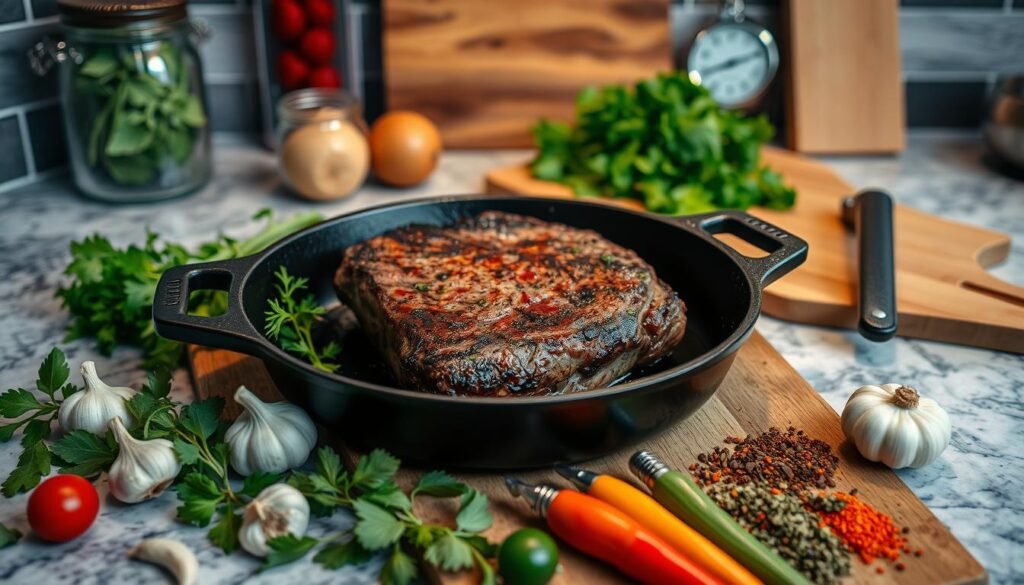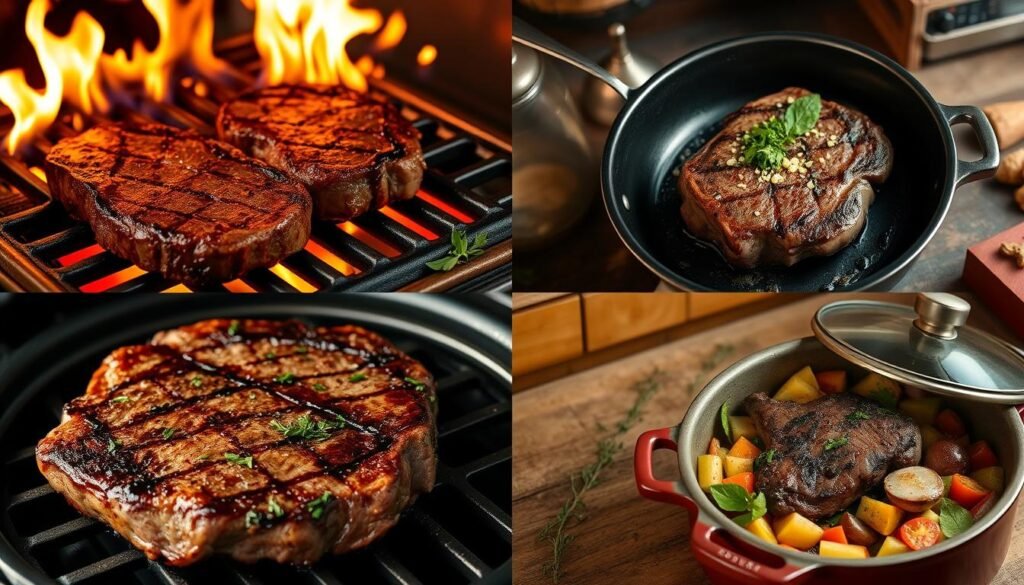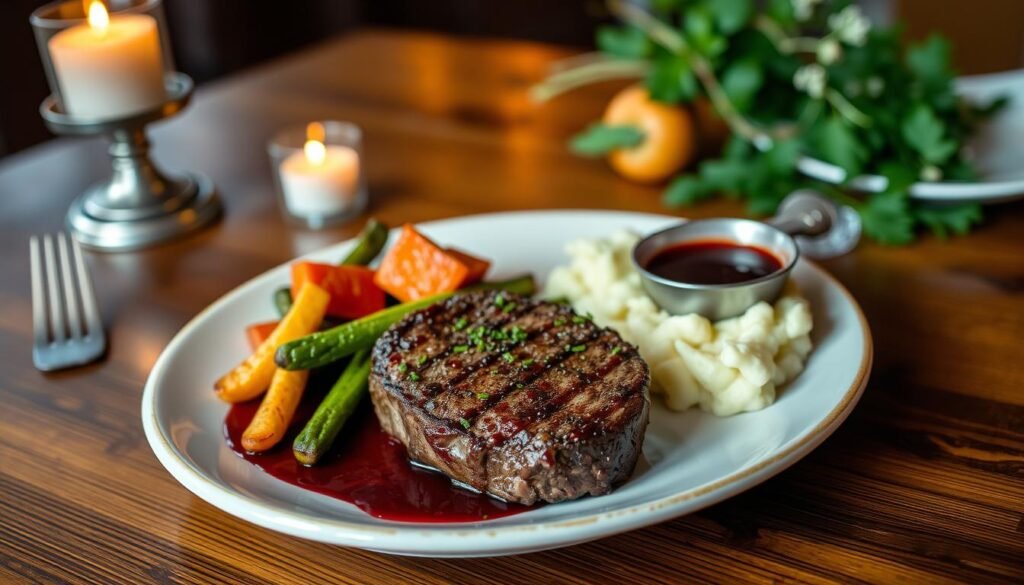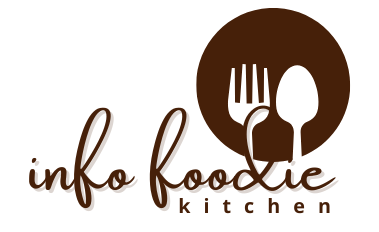Every great culinary journey starts with passion and a desire to find hidden gems. The chuck eye steak, often overlooked, is about to become your new kitchen favorite. Imagine turning an affordable cut into a restaurant-quality masterpiece that will wow your family and friends.
As a home cook, you might wonder how to make this budget-friendly chuck eye steak extraordinary. The secret is understanding its unique traits and mastering a few professional techniques. These can transform an affordable cut into a delicious dining experience.
This guide will show you everything you need to know about preparing the perfect chuck eye steak. You’ll learn why it’s called the “poor man’s ribeye” and how to unlock its full flavor in your kitchen.

Key Takeaways
- Chuck eye steak offers premium flavor at a budget-friendly price
- Proper preparation is key for achieving restaurant-quality results
- Understanding cooking techniques can maximize tenderness and taste
- The right seasoning can elevate this affordable cut
- Cooking methods vary, but precision is key to perfect doneness
Understanding Chuck Eye Steak: The Poor Man’s Ribeye
Looking for a tasty steak that’s easy on the wallet? this recipe is your answer. It’s known as the “poor man’s ribeye” and offers a great taste at a lower price.
The chuck eye steak comes from the cow’s shoulder, near the fifth rib. It’s similar to the ribeye but costs less. Only two chuck eye steaks are found per cow, making them rare and sought after.
Location and Cut Characteristics
- Sourced from the chuck primal, weighing approximately 100 pounds
- Represents about 30% of a whole side of beef
- Located near the ribeye section, sharing similar marbling characteristics
Comparison to Other Premium Cuts
Chuck eye steak is a great value compared to other cuts like teres major steak. It has a milder flavor than ribeye but is rich and beefy. Steak lovers enjoy its taste.
What Makes It Special
Chuck eye steak is versatile. You can grill it or grind it for meatloaf or meatballs. It cooks in four to five minutes per side for medium-rare, making it easy for home cooks to master.
“A great steak doesn’t have to cost a fortune” – Home Cooking Wisdom
Essential Tools and Equipment for Perfect Steak Cooking
Cooking the perfect chuck eye steak needs more than skill. You’ll need the right tools to turn this affordable cut into a top-notch meal. Professional chefs say the right equipment is key to a great cooking experience.
Here are the essential tools for a delicious steak:
- Cast-iron skillet: The ultimate tool for a perfect sear and rich flavor
- Reliable meat thermometer for precise doneness tracking
- Long-handled tongs for safe meat handling
- Sharp chef’s knife for trimming and cutting
- Heavy-duty cutting board
These specialized tools make cooking chuck eye steak much easier. A cast-iron skillet holds heat well and creates a beautiful crust. The meat thermometer helps you get the steak to your exact doneness.
“The right tools transform an average cook into a kitchen maestro.” – Professional Chef Recommendation
Optional advanced equipment can take your steak cooking to the next level:
- Sous vide machine for precise temperature control
- Grill pan for indoor grilling experience
- Instant-read digital thermometer
Investing in quality cooking tools will greatly improve your chuck eye steak results. Each piece of equipment is important for a perfectly cooked, flavorful meal.
Selecting and Buying Quality Chuck Eye Steak
Finding the perfect steak takes some knowledge and careful picking. This cut is a great choice for those watching their budget. It’s a tasty alternative to pricier beef options.
How to Choose the Best Cut
Here’s what to look for in a chuck eye steak:
- Rich marbling throughout the meat
- Deep red color with minimal brown spots
- Consistent thickness (around 1-1.5 inches)
- Minimal excess liquid in packaging
Where to Buy Your Chuck Eye Steak
For top-notch steak, try these places:
- Local butcher shops
- Specialty meat markets
- Well-stocked grocery store meat departments
- Online meat retailers specializing in premium cuts
Price and Value Considerations
Chuck eye steak is a fantastic flank steak substitute. It’s priced lower than ribeye but tastes just as good. It’s tender and flavorful, making it a great value.
| Cut | Average Price per Pound | Flavor Profile |
|---|---|---|
| Chuck Eye Steak | $12.99 | Rich, beefy |
| Ribeye | $22.99 | Extremely rich |
| Flank Steak | $16.99 | Lean, moderate |
“Chuck eye steak delivers premium taste without the premium price tag.”
Remember, each cow has only two chuck eye steaks. This makes it both special and rare. With the right choice, you get a delicious, affordable meal that’s as good as pricier cuts.
Professional Preparation Techniques
Preparing a chuck eye steak like a pro starts with knowing the key steps. These steps turn an ordinary cut into a top-notch meal. Ranch steak preparation needs focus on detail and precise methods to improve your cooking.
Start by taking your steak out of the fridge 30-45 minutes before cooking. Letting it come to room temperature ensures it cooks evenly. This prevents tough, uneven results. Dry the steak with paper towels to remove extra moisture. This step helps in searing better and creating a tasty crust.
“Preparation is the secret weapon of great chefs” – Culinary Wisdom
Essential Preparation Steps
- Remove steak from refrigerator 30-45 minutes before cooking
- Pat meat completely dry with clean paper towels
- Inspect the steak for any excess fat or uneven edges
- Place on a clean cutting board for seasoning
Seasoning is an art when preparing chuck eye steak. Generously sprinkle kosher salt and freshly ground black pepper on both sides. For more flavor, make a dry rub with garlic powder, dried herbs, and paprika.
Professional Seasoning Techniques
- Apply salt 30 minutes before cooking
- Use coarse kosher salt for better flavor penetration
- Grind fresh black pepper directly onto the steak
- Gently press seasonings into the meat’s surface
Professional chefs know that proper prep can make a chuck eye steak unforgettable. By using these techniques, you’ll bring out the best in this flavorful cut.
The Art of Seasoning Chuck Eye Steak
Turning a simple chuck eye steak into a masterpiece starts with seasoning. You need to pick the right ingredients and techniques. These will make this beef cut taste like it’s from a top restaurant.
Basic Seasoning Guidelines
Great seasoning for chuck eye steak is all about keeping it simple. Begin with kosher salt and black pepper. Sprinkle these on the steak about 40 minutes before cooking. This lets the meat soak up the flavors.
- Use coarse kosher salt for better flavor penetration
- Freshly ground black pepper provides maximum taste
- Pat the steak dry before seasoning
Creating Custom Spice Blends
Enhance your chuck eye steak with a custom spice blend. Pick spices that highlight the meat’s rich flavor.
| Spice Blend Component | Quantity | Flavor Profile |
|---|---|---|
| Smoked Paprika | 1 tbsp | Smoky depth |
| Garlic Powder | 1 tsp | Savory undertone |
| Dried Thyme | 1/2 tsp | Herbal notes |
Marination Tips and Timing
Marinating your chuck eye steak can enhance its taste and tenderness. Aim for 2-4 hours of marinating. A good marinade includes olive oil, red wine vinegar, garlic, and herbs.
“The secret to a perfect chuck eye steak is patience in seasoning and respect for the meat’s natural qualities.”
Even though chuck eye steak is called the “poor man’s ribeye,” you can make it taste like a luxury dish. Try different flavors and find what works best for you.
Mastering Different Cooking Methods

Cooking steak requires mastering several techniques. Your choice of cooking method can elevate this affordable cut to a restaurant-quality meal.
Recommended Cooking Techniques
- Grilling: High-heat method perfect for this recipe
- Pan-searing: Creates delicious caramelized exterior
- Oven-roasting: Ensures even internal cooking
- Slow-cooking: Breaks down tough muscle fibers
Chuck eye steak is different from teres major steak. It can be cooked in many ways. The trick is to know the meat’s special traits and pick the best method.
Cooking Method Comparison
| Method | Temperature | Cooking Time | Best For |
|---|---|---|---|
| Grilling | 450°F | 4-6 minutes per side | Crispy exterior, juicy interior |
| Pan-searing | High heat | 3-4 minutes per side | Quick preparation, rich flavor |
| Oven-roasting | 250°F | 25-30 minutes | Even cooking, tender result |
Professional chefs suggest trying different methods to find your favorite. Each method offers a unique taste and texture.
“The right cooking method can transform an ordinary chuck eye steak into an extraordinary dining experience.” – Culinary Expert
Don’t forget to let your steak rest after cooking. This step lets juices spread out, making it tender and flavorful.
Temperature Guide and Cooking Times
Cooking the perfect steak needs precision and knowing how to control temperature. This guide will help you make a delicious ranch steak, just like a pro chef.
Doneness Levels Explained
Getting the right doneness is key to enjoying your steak. Here are the internal temperatures you should aim for:
- Rare: 125°F (52°C)
- Medium-Rare: 135°F (57°C) – This is the favorite of most steak lovers
- Medium: 145°F (63°C)
- Medium-Well: 150°F (66°C)
- Well-Done: 160°F (71°C)
Mastering Meat Thermometers
A good meat thermometer is essential for perfecting your steak. Stick the thermometer into the thickest part of the meat, but avoid fat or bone. Digital instant-read thermometers give the most accurate readings.
The Importance of Resting Periods
Resting your steak is a crucial step many home cooks overlook. After cooking, let your ranch steak rest for 5-10 minutes. This allows the juices to spread, making your steak tender and flavorful.
“Patience is the secret ingredient to a perfectly cooked steak.” – Professional Chef Tip
Carryover cooking means your steak’s temperature will rise 5-10 degrees after you remove it from the heat. So, take the chuck eye steak off the cooking surface a bit before it reaches your desired temperature. This prevents it from getting overcooked.
Creating Restaurant-Style Accompaniments

To elevate your steak to a five-star meal, choose the right sides. When using chuck eye steak as a flank steak substitute, the right sides can make your dish stand out.
Gourmet Compound Butter Recipes
Homemade garlic herb butter can make your steak taste amazing. To make this special topping, mix:
- Softened unsalted butter
- Freshly minced garlic
- Chopped herbs like parsley and thyme
- Pinch of sea salt
Perfect Side Dish Pairings
Your chuck eye steak needs sides that match its rich taste. Here are some gourmet options:
- Roasted Brussels sprouts with bacon
- Creamy scalloped potatoes
- Grilled asparagus with lemon zest
“The right accompaniment can transform a good steak into an extraordinary dining experience.” – Chef Michael Roberts
For plating ideas, check out @_infoodie_ on Instagram. They show beautiful steak presentations that can make your home cooking look great.
Quick Cooking Times
Most side dishes take 15 minutes to 90 minutes to prepare. Pick recipes that fit your schedule but are also gourmet.
Conclusion
Your journey with chuck eye steak is more than cooking. It’s about turning an affordable cut into a top-notch meal. You’ve learned how to make this steak taste amazing without spending a lot.
this steak lets you make fancy meals without the high cost. It’s close to the ribeye and has lots of marbling. This means you can try different cooking ways, like grilling or slow cooking. Each method brings out special textures and tastes.
Learning to cook chuck eye steak is all about trying new things and having fun. Whether it’s a quick dinner or a big weekend meal, you’ll always get great results. This affordable cut proves that you don’t need to spend a lot to enjoy great food.
As you get better at cooking this steak, you’ll feel more confident in the kitchen. You’ll turn simple ingredients into amazing meals that wow everyone. Keep trying new things, stay curious, and always keep improving your cooking skills.
FAQ
What exactly is chuck eye steak?
This recipe comes from the chuck primal section of the beef. It’s near the ribeye and is called the “poor man’s ribeye.” from the cow’s shoulder and has a rich, beefy taste. It’s also moderately tender.
How does chuck eye steak compare to ribeye?
this recipe is similar to ribeye but less expensive. It’s cut near the ribeye and has similar flavor and texture. It has less marbling and is chewier than a ribeye.
What’s the best way to cook chuck eye steak?
Pan-searing, grilling, and oven-roasting are great ways to cook it. Make sure it’s at room temperature and season well. Cook to medium-rare (135°F) for the best taste and tenderness. A cast-iron skillet or grill helps get a perfect sear.
Where can I buy chuck eye steak?
You can find it at butcher shops, grocery stores, and online. Look for good marbling and a bright red color. Some call it “chuck eye ribeye” or “poor man’s ribeye.”
Is chuck eye steak a good substitute for other cuts?
Yes, this recipe is a great choice for those looking to save money. It’s perfect for stir-fries and grilled dishes. Its rich flavor and affordable price make it a favorite among home cooks.
How should I season chuck eye steak?
For the best taste, use kosher salt and black pepper. Season it about 40 minutes before you cook. You can also try dry rubs or marinades to add more flavor.
What internal temperature should I cook chuck eye steak to?
Cook it to different temperatures for different doneness levels. Rare is 125°F, medium-rare is 135°F, and so on. A meat thermometer ensures it’s cooked just right and stays juicy.
How long should I let the steak rest after cooking?
Let it rest for 5-10 minutes after cooking. This makes it tender and flavorful. Cover it loosely with foil to keep it warm.

1 thought on “How to Cook Chuck Eye Steak Like a Professional Chef”